ASUS VG236H 23-inch 3D Display Review: 120Hz is the Future
by Brian Klug on August 7, 2010 2:48 AM ESTColor Quality
Now let’s get to the meat of the display characteristics. As usual, we report two main quality metrics: color accuracy (Delta-E) and color gamut. Color gamut refers to the range of colors the display is able to represent with respect to some color space. In this case, our reference is the AdobeRGB 1998 color space, which is larger than the sRGB color space. So our percentages are reported with respect to this number, and larger is generally better.
Color accuracy (Delta E) refers to the display’s ability to display the correct color requested by the GPU and OS. The difference between the color represented by the display, and the color requested by the GPU is our Delta-E, and lower is better here. In practice, a Delta E under 1.0 is perfect - the chromatic sensitivity of the human eye is not great enough to distinguish a difference. Moving up, a Delta E of 2.0 or less is generally considered fit for use in a professional imaging environment - it isn’t perfect, but it’s hard to gauge the difference. Finally, Delta E of 4.0 and above is considered visible with the human eye. Of course, the big consideration here is frame of reference; unless you have another monitor or some print samples (color checker card) to compare your display with, you probably won’t notice. That is, until you print or view media on another monitor. Then the difference will no doubt be apparent.
As I mentioned in our earlier reviews, we’ve updated our display test bench. We’ve deprecated the Monaco Optix XR Pro colorimeter in favor of an Xrite i1D2 since there are no longer up-to-date drivers for modern platforms.
For these tests, we calibrate the display and try to obtain the best Delta-E we can get at both 200 nits of brightness for normal use, and 100 nits for print brightness. We target 6500K and a gamma of 2.2, but sometimes the best performance lies at native temperature and another gamma, so we try to find what the absolute best performance could be. We also take an uncalibrated measurement to show performance out of the box using either the manufacturer supplied color profile, or a generic one with no LUT data. For all of these, dynamic contrast is disabled.
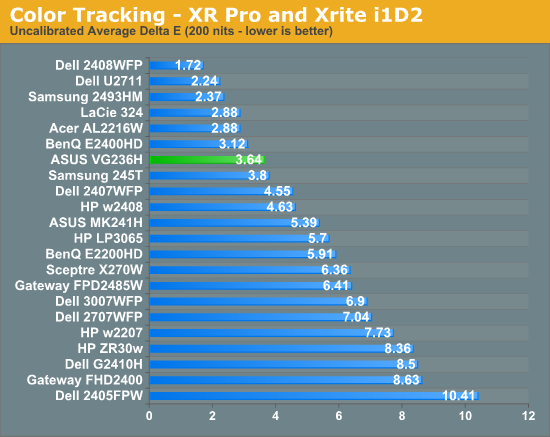
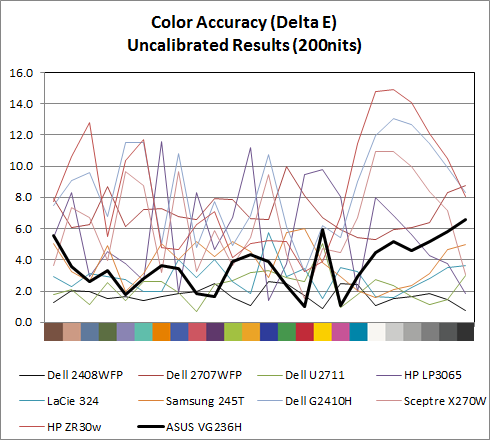
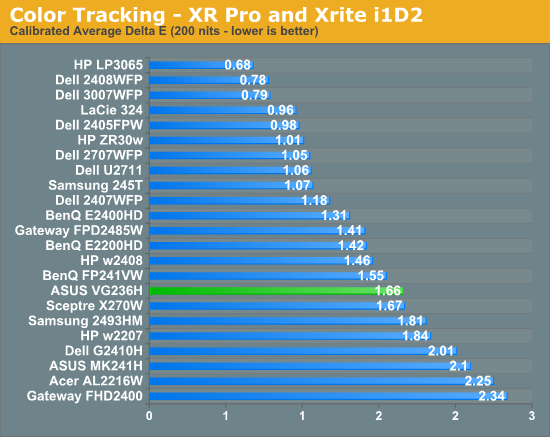
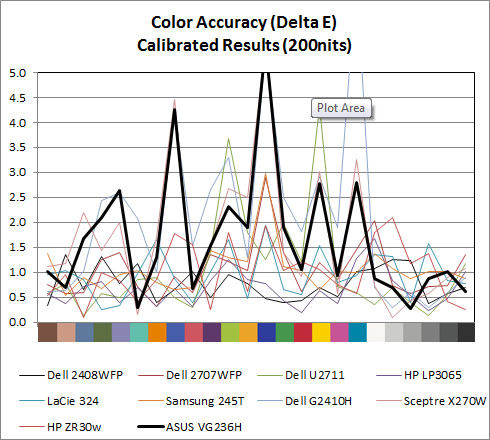
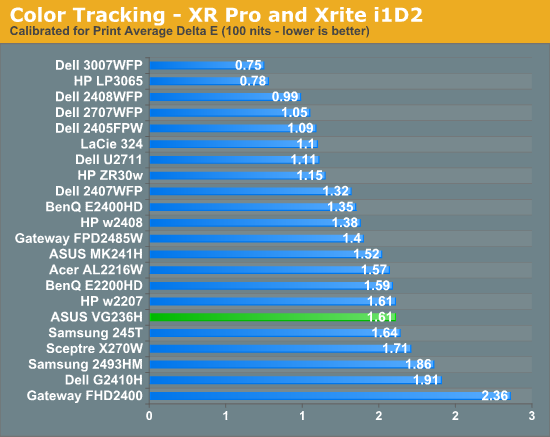
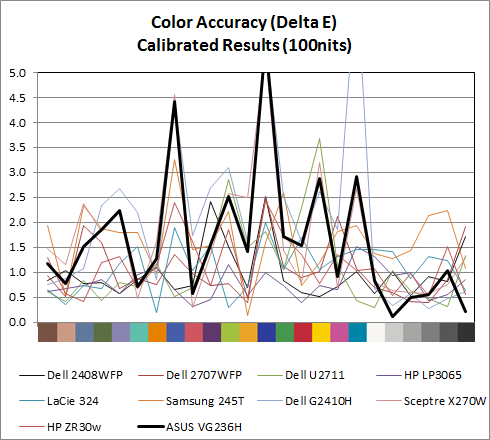
Performance uncalibrated, entirely out of the box is actually very good, at a respectable 3.64. When I first started working on the VG236H I didn’t notice any color tints or weird hues, and upon measuring the display, found the white temperature to be almost exactly 6600K, very close to our 6500K target for calibration. This is nice to see out of the box. For gamers interested in ballpark color reproduction but not professonal level absolute colormetric reproduction, this is adequate.
Moving on, at 200 nits the VG236H gets a bit more accurate, down to 1.66, but still isn’t quite as good as an IPS panel. Still, not bad for a TN. Going down to 100 nits, we get a bit better, moving down to 1.61, but still not that elusive sub 1.0 the highest quality displays can deliver. What about gamut?

As expected, gamut is right around where we’d expect it to be for the TN, sRGB display. Interestingly enough, the OSD controls do have an sRGB mode, though I don’t think it’s as necessary as it would be on say a wide gamut display. But it’s there for certain.











121 Comments
View All Comments
synaesthetic - Monday, August 9, 2010 - link
If your livelihood depends on color accuracy, you can damn well bet it's worth spending money on. Monitors cheaper than $300 have terrible color reproduction.Seikent - Saturday, August 7, 2010 - link
I have the Samsung 2233RZ monitor (120 hz, 3d ready, 16:10), it is a bit cheaper than this one, but it has some limitations.I don't have the shutter glasses, but I don't care too much because I don't have a Nvidia card. I bought it just because the 120 hz refresh rate. Playing with vsync on is awesome, the visual experience is much better, it feels fluid and it is hard to go back. It is hard to understand because you can't see it how it feels without having this monitor in front of you. I recommend you to try one.
JGabriel - Saturday, August 7, 2010 - link
Brian King: "I’d say the vertical angle you get isn’t quite as advertised, but honestly if you’re viewing the monitor from so far down below that this is noticeable, you’re probably doing something wrong ..."Or viewing it in portrait mode after attaching it to a pivot arm. Really, Brian, that should have occurred to you, as you bragged about "rolling your own" only a few paragraphs earlier.
.
JGabriel - Saturday, August 7, 2010 - link
Whoops, sorry for getting your last name wrong, Brian. I mis-read it somehow. Apologies..
Brian Klug - Saturday, August 7, 2010 - link
I agree, but the primary weird viewing angle is from below. From above, it seems much better (like many other TN panels, which is quite typical). I've encountered exactly that issue before putting a TN panel in portrait, and it definitely isn't desirable.I would definitely not recommend doing that with this ASUS ;)
-Brian
FH123 - Saturday, August 7, 2010 - link
Are 3D games, like Metro 2033, any better than what we get to see at the cinema? I saw Avatar (the film) and thought the 3D effects were laughable. In many scenes I could discern at most 3 or 4 planes of depth and, within those planes, everything looked flat. For example there might be a computer monitor in the foreground, then Sigourney Weaver, then the background. Where 3D worked it was mostly when things popped into the foreground, but the actors faces and backgrounds usually looked completely flat. South Park immediately sprang to mind. The actors looked like cardboard cut-outs in front of a background picture.Am I the only one noticing this effect? I admit my experience is very limited, as I walked out of Avatar half-way through and haven't watched anything 3D since. Nor do I have the desire to. The 3D effect was jarring and the film lost much of it's brightness, contrast and color saturation. What's the point? I own a good (JVC) projector. Something well recorded and not over-processed like, say, Treme (the TV series), looks far better to me than what I saw at the cinema that day. Depth perception, in that case, comes from low black-levels and proper dynamic range. Less dramatic, but it seems better to me.
Having said that, perhaps there is some advantage games have over films, even films that rely heavily on CGI, such as Avatar? Do they, perhaps by virtue of having a depth coordinate for every pixel on the screen, give a better continuity of depth perception?
Brian Klug - Saturday, August 7, 2010 - link
I agree with you, so that weird senstation is partly an artifact of 3D being added in after the fact, and partly just poor cinematography.The nice thing about games is that the 3D models are there already and have much finer meshes. I'd say that on the whole, no, that experience of things only existing in a few planes of depth is completely absent from gaming in 3D in any of the games I've tested thus far.
-Brian
nvmarino - Saturday, August 7, 2010 - link
Brian, great review, thanks!One of the benfits of a true 120Hz display (120Hz at the input) you didn't mention are the benefits for HTPC usage - a framerate that's evenly divisible by 60 and 24 means you can output both 24fps and 60fps content without having to change the refresh rate in the video card settings. Any chance you can confirm if the monitor supports HDCP on the DVI input? Also, any chance you could see if the commercial Blu-ray players (i.e. PowerDVD, TMT3, and WinDVD) play nice when outputting @120hz? Would also be good to know if Windows Media Center has any issues when outputting @120Hz as well!
Also, one minor gripe about your review - I think you're incorrectly referring to the system you're testing as "3D Vision Surround". "3D Vision *Surround*" is when using 3D Vision with multiple displays. Since you're reviewing with a single display it's just "3D Vision"...
Brian Klug - Saturday, August 7, 2010 - link
Excellent catch on 3D Vision Surround versus 3D Vision, fixed that!I'll test to make sure, but I'm 90% certain that it supports HDCP. It'd be absolutely unforgivable to be shipping a monitor in 2010 without HDCP. Having HDMI onboard pretty much guarantees that at least that input does, but I'll double check. I don't expect any problems though.
-Brian
Brian Klug - Saturday, August 7, 2010 - link
Just tested with PowerDVD 10 Mark II Version 10.0.1830.51 and playback is perfect - tried a variety of BD titles. Looks good at 120Hz (no stuttering). HDCP apparently does work over the DVI-D datapath.-Brian